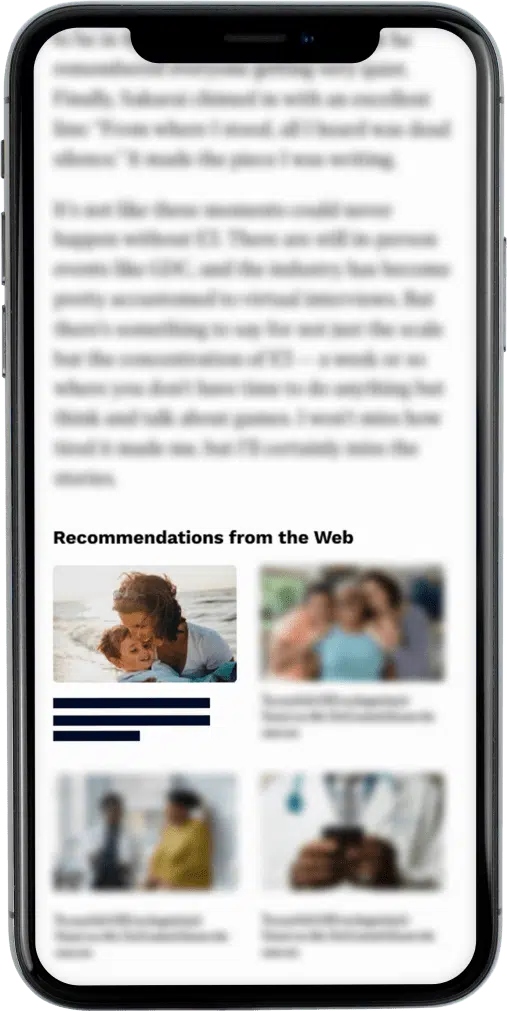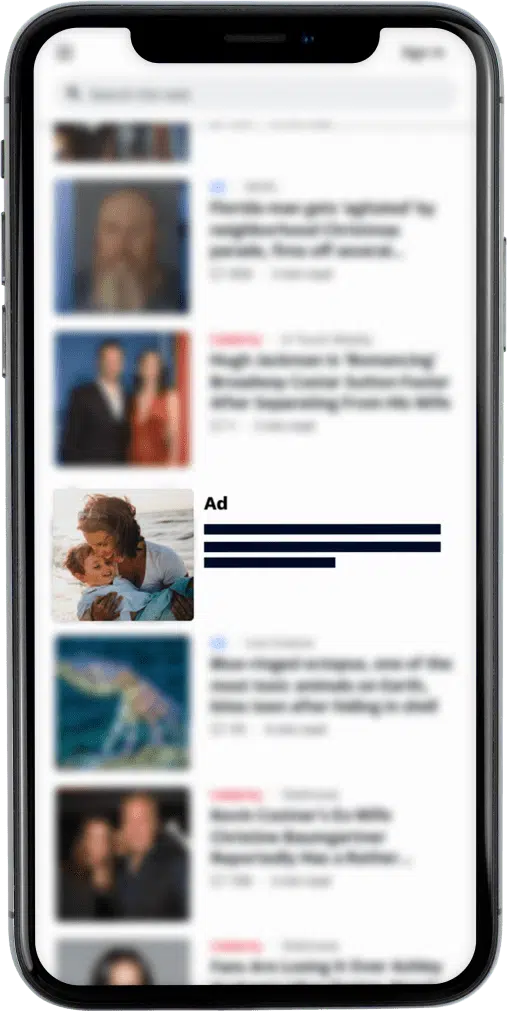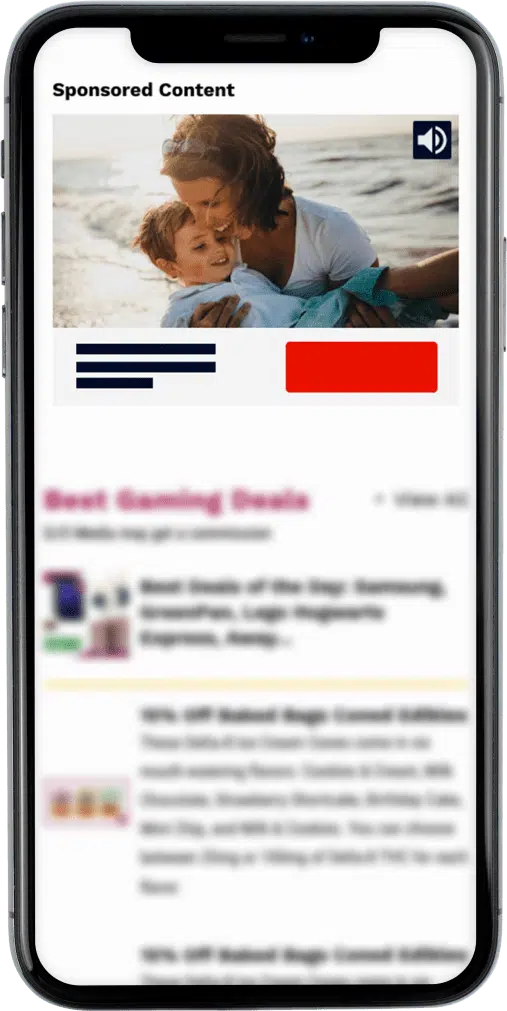Healthcare native ads can be pivotal in establishing connections, providing value, and fostering a positive brand image within the healthcare industry. Compared to traditional banner ads or pop-ups, native ads offer a more seamless and less disruptive user experience by matching the publisher platform’s design and format. Beyond solely promoting products and services, brands can use native healthcare advertising to educate their target audiences about various health conditions, treatments, or innovations to demonstrate themselves as experts in their field and offer solutions to customers’ challenges.
In this article, we discuss how native advertising works with prime examples, the benefits of implementing healthcare native ads, and best practices for using native ads to boost engagement and sales.
Key Takeaways
- Native ads are paid ad placements that seamlessly integrate with surrounding web content to capture the reader’s attention without disrupting the user experience. Learn more.
- Native ads perform best with display ad campaigns to help build higher engagement and CTR. Learn more.
- Native ad best practices include determining marketing goals, researching target audiences, running native and display ads simultaneously, and crafting compelling copy that speaks to customer challenges. Learn more.
What Are Native Ads?
Native ads are paid ad placements that imitate the format, tone, and style of neighboring content on a website, social platform, or app so that they don’t disrupt the user experience. They blend into the web page’s content to capture the reader’s attention and encourage engagement without interruption. While consumers recognize1 that native ads constitute a form of advertising, they are less likely to find them intrusive because they offer a smoother consumer experience.
When executed effectively, native advertising captures attention and builds credibility by delivering valuable content in a non-disruptive manner. It’s a strategic way for brands to successfully engage, educate, and create a lasting impression on their audience.
How Do You Spot Native Advertising?
There are telltale signs2 to spot native ads online:
- The ad looks like content on the page but still clearly promotes calls-to-action, such as visiting a website or downloading an app.
- Users see a label that reads “sponsored,” “promoted,” “recommended by,” or “recommended for you” to denote that the ad is paid content.
- There are visible opt-out link options for users.
- The ad’s block is marked as “Recommended Stories” or features the native network’s icon.
Native Ads Vs. Display Ads
While native ads blend into surrounding content, display ads stand out and capture attention. Display ads feature a combination of text, multimedia, and a URL that takes users to a brand’s website to learn more about the advertised product or service. Advertisers can also implement videos, pop-up features, and other interactive elements like animation to call attention to the ad.
Native ads enhance engagement, session time, and CTR, while display ads contribute to brand awareness, recall, and purchase intent. Display ads are ideal for retargeting campaigns to target web visitors with ads when they’re scrolling on other web pages. These ads are more likely to grab the user’s attention and remind them to visit your website to follow through with a purchase.
Native Ad Formats
Native ads fit the look and feel of a particular platform or website through custom layouts, colors, and formats. Custom native ads are best when aiming for brand consistency across various platforms or when using a particular design or layout is essential. However, there are many native ad formats marketers can use depending on the campaign and broader marketing goals.
In Feed Ads

In-feed ads are paid ad placements within the content feed of a website, social media platform, or app. They mimic the appearance and tone of the content around them. They’re best used for generating higher visibility and engagement on social media or content-heavy websites because they merge well with the platform’s content.
Recommendation Widgets

Recommendation widgets are found at the end of articles or on the side of a web page to keep users on-site. They suggest related content or sponsored posts that may similarly interest readers.
Promoted Listings

Promoted listings are featured products or services in an e-commerce platform’s marketplace or directory. They appear like regular listings but are highlighted for visibility to advertise specific products or services.
In-Ad With Native Elements Units

These ads combine standard ad formats such as banners or videos with native elements like contextual information, related articles, or interactive features that mimic the surrounding content. These ads aim to enhance user engagement by assimilating the overall look and feel of the platform while providing additional contextual relevance.
Video Ads

Native video advertising displays in-feed or in-game video content on web pages, social media networks, or apps. In the context of in-feed ads, they’re hosted outside a video player and begin playing automatically without sound when the user scrolls to the video position. Alternatively, in-game native ads3 appear within a mobile game or app, involving elements such as in-game billboards or brand-sponsored levels tailored to fit the user’s online habits. Playable in-game ads4 allow users to get rewards for watching the video ad and typically lead users to an external landing page upon clicking.
Native Ad Sizes
Native ad sizes depend on the publisher’s requirements. However, the International Advertising Bureau (IAB)’s IAB New Standard Ad Unit Portfolio5 outlines the ad specifications for native ad sizes:
5 Native Ad Best Practices
1. Determine Marketing Goals
Establishing clear marketing objectives, such as enhancing brand awareness or generating more leads, will help establish guidelines before launching your native ad campaign. A plan can also help you determine which metrics will help measure success (CTR, return on spend, etc) to adjust tactics if necessary. Each ad should align with your broader business goals rather than achieving individual metrics like capturing higher CTR. By developing a strategic vision, healthcare marketers can make more of an impact and contribute meaningfully to the company’s success.
2. Understand Your Target Audience
Before launching a successful ad campaign, you must understand your target HCP audiences’ demographics to better determine their interests and values. Parameters such as license type, specialty, prescribing behavior, age, location, and device type can help marketers extend their reach to specific demographics of users or meet marketing goals. Knowing your audience will help to produce content that caters to their pain points and resonates with their unique needs. Conducting market research on your target audience can also shape how you communicate with them by adopting a specific tone and phrasing that speaks to their demographic(s).
For example, recent statistics from the U.S. Bureau of Labor Statistics6 found that nearly two-thirds of all HCPs are in the prime working ages of 25 to 54, particularly occupations that require more advanced degrees, like dentists and physicians. Considering this information in the context of generational preferences and spending habits can make a significant difference when strategizing campaign details.
3. Run Native & Display Ads Simultaneously
For best results, marketers should run native and display ads simultaneously for at least three months. Display ads drive reach, whereas native ads drive engagements. When users visit a website, they’re prompted to accept or reject cookies, which is their first interaction with your ad tracking. If they leave the first visit, they may still engage at a later time. Marketers should run native ads for at least three months to understand their effectiveness and optimize performance.
4. Keep It Simple
Writing in a conversational style fosters authenticity and connection with an audience, prompting higher engagement with the ad. Using short sentences and bullet points and strategically incorporating multimedia to break up the text enhances readability. By keeping messaging straightforward, natural, and friendly, audiences can relate more to the ad’s talking points and are more inclined to follow through on taking action to learn more about a brand’s services.
5. Offer Value
With limited ad space, ensuring each word serves a purpose toward the desired CTA improves the ad’s effectiveness. Research the challenges your audience faces and then address those issues in your copy with solutions to those challenges to help gain your audience’s trust. Weaving an engaging, relatable narrative that speaks to those pain points will create an experience that strikes a chord with customers so they can see the advantages of buying from your brand.
Focus on enriching the audience’s lives, whether through valuable information that speaks to their pain points or through relatable entertainment like a funny clip that is memorable and shareable.
Benefits of Using Native Ads
Drives Higher Engagement
On average, native ads generate higher brand engagement than display ads because they camouflage into adjacent editorial content, making them more relevant to the user experience and far less disruptive. Consumers7 tend to look at native ads 53% more frequently than display ads and native ads create an 18% increase in purchase intent and a 9% higher lift for brand affinity. Native ads also have a 0.2% average click-through rate (CTR) compared to an average of 0.05% for display ads. The average is even higher on mobile devices for premium native ads at 0.38%.
Increases Session Time
An impactful native ad offers practical worth to users by providing information or solutions related to their interests. By sparking users’ interests, they’re more likely to engage with the ad content, which keeps them on the page or within the app for longer. Also, because native ads are tailored to be less disruptive to the user experience, audiences are naturally encouraged to stay longer on the platform.
Combats Ad Fatigue
Ad fatigue is when an audience grows disinterested, tired, or frustrated by repetitively encountering ads. It’s often because they disrupt the user experience by occupying most of the screen or taking too long to load. Users feeling frustrated by ads are less likely to engage with or click on them to learn more about the brand. However, because native ads fit seamlessly within editorial content, users feel less bombarded and, therefore, less fatigued by ads.
Leads to Better Brand Recognition
Native advertising can be a powerful tool for brand storytelling and establishing authority within a field in a format that resonates with the platform’s audience. By combining stunning visuals, creative headlines, and concise descriptions, advertisers can craft a narrative showcasing the product or service and the brand’s values, mission, and unique selling points. These strategies can help retain the audience’s attention and boost brand recognition
3 Best Healthcare Native Ad Examples

Company: Michael J. Fox Foundation
Publisher: Yahoo
Why It Works
This ad for the Michael J. Fox Foundation is also a great example of an in-feed native ad on Yahoo. The ad perfectly melds into its surroundings, emulating the format of bordering articles. However, users can still see it’s an ad because it’s listed at the top of the text with the organization sponsoring the content.

Company: American Heart Association
Publisher: U.S. News & World Report & Brandfuse
Why It Works
In-feed native ads can also appear in the sidebar of web pages. This ad by the American Heart Association8, in conjunction with Brandfuse, promotes reputable healthcare providers around the country for patients in need of heart and stroke care. Featured in a health-related article on the U.S. News & World Report9, readers can see it’s an ad because it clearly states the phrase “ad content”; however, the ad isn’t intrusive to the user experience because it matches surrounding content.

Company: Jazz Pharmaceuticals
Publisher: USA Today
Why It Works
This ad from Jazz Pharmaceuticals (and the other ads below it) is an excellent example of a recommended widget native ad. Recommended widget native ads often appear at the end of a piece of content, and they’re typically highlighted as recommended reading or suggested reading for users based on the content they’re consuming. For instance, this ad was presented as relevant content among a list of health-related news articles on USA Today.
Maximize Your Healthcare Marketing Strategy With Native Ads
Delivering meaningful content and engaging audiences in a way that feels organic and valuable can help healthcare brands advertise their services and products more effectively.
By positioning brands as authoritative sources of valuable insights and information, native advertising helps build relationships and credibility over time. Our marketing experts at Adfire Health can work with your brand to successfully execute healthcare native ad campaigns so you can see significant results.
At Adfire Health, we work with healthcare marketers to create optimized, highly effective, data-based digital engagement strategies. With Thumbprint™, our segmented data ecosystem of over 8.2 million healthcare professionals, we can offer nationwide 1:1 engagement and access to healthcare professionals.
We bring our years of hands-on experience to every new campaign and work with you to get the best results possible. Contact us to learn more about what we can do for your business.
Sources
- Disguised “native” ads don’t fool us anymore. (2023, December 6). Stanford Graduate School of Business. https://www.gsb.stanford.edu/insights/disguised-native-ads-dont-fool-us-anymore
- Native advertising: The smarter way. (n.d.). Outbrain. https://www.outbrain.com/native-advertising/
- Wheeler, S. (2021, December 15). What are in-game ads? The definitive 2023 guide. Kevel. https://www.kevel.com/blog/what-are-ingame-ads
- Kovalenko, I. (2023, September 21). Engage, convert, repeat: The playable ads revolution. SmartyAds. https://smartyads.com/blog/playable-ads/
- Native ads. (2017). International Advertising Bureau. https://www.iab.com/wp-content/uploads/2019/04/IABNewAdPortfolio_NativeAds_Spec.pdf
- Spotlight on statistics. (2023, June 7). U.S. Bureau of Labor Statistics. https://www.bls.gov/spotlight/2023/healthcare-occupations-in-2022/home.htm#:~:text=Nearly%20two%2Dthirds%20of%20all,54%2Dyear%2Dold%20workers.
- Wong, E. (2023, March 6). Native vs. Display Ads: Which Are Better? Paved. https://www.paved.com/blog/native-ads-vs-display-ads/#:~:text=On%20average%2C%20native%20ads,19%25%20for%20display%20ads
- The road to a healthy heart starts here: How to find heart and stroke care near you, measured by the American Heart Association. (n.d.). Brandfuse. https://www.usnewsbrandfuse.com/AmericanHeartAssociation/
